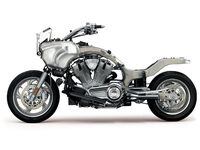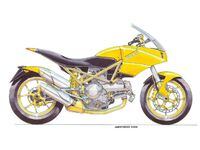A powerful element of a motorcycle's appeal is its simplicity: basically an engine and two wheels. But today's motorcycle designers know how challenging it is to package everything necessary into that deceptively simple basic plan. Every year there's more to package. Power increases and noise regulations become more restrictive, substantially increasing airbox and muffler volume. Powerful engines use more fuel, which means more fuel capacity. Fuel injection replaces carburetors-add an ECU and a fuel pump. Aluminum spar frames and fully braced swingarms take up more volume than skinny steel tubes. Find room for environmental controls such as evaporative emissions containers and catalytic converters. Motors are needed to control downstream exhaust valves, secondary throttle plates, variable intake tuning and even windscreen height. Add ABS and GPS and maybe a sound system. And add a wiring harness with enough circuits to bring it all together.
There has been some useful downsizing. Batteries have gotten smaller. Advanced magnet technology has reduced the size of some starter motors and alternators. Ignition coils can now sit inside the cylinder head. But getting everything in place, keeping weight and weight distribution under control, giving parts the necessary clearances and making sure that sensitive ones are protected from heat and vibration...that's a challenge. It's not like a car, where you can find unused space under the hood, in the trunk and maybe in the wheel wells. With a motorcycle, if you don't create the needed space in the original design, you're unlikely to find it later.
Erik Buell's company is arguably the most creative and innovative in the world when it comes to packaging. Buell wanted to build a small bike around a large engine, a feat literally impossible without re-thinking standard packaging practice. The company's boldest move was to consider combining some major component functions, finally realizing it would be possible to design an aluminum frame that actually held fuel, and a fully braced swingarm that doubled as an oil tank. (Putting fuel in the frame wasn't as easy as it sounds; a clever patented design allows the steering head to separate from the frame in a collision of determined severity, keeping the fuel in the frame and reducing the risk of fire.)
Victory motorcycles, with its new Vision touring cruiser, has come up with packaging solutions to rival Buell's. It combined the functions of the frame and airbox, using the large, cast-aluminum structural tube over the engine to feed air from the cool area forward of the steering head to the throttle bodies tucked into the engine's vee. I used a similar device in my 2002 Vincent prototypes, using a frame backbone of 6-inch square aluminum tubing to feed air from just behind the headlight to the throttle bodies of the Honda RC51 engine.
Kawasaki's big 1400cc fours use a frame that doubles as an airbox as well, but Victory's frame/airbox is just part of its innovative approach. The rear part of the Vision frame is also cast aluminum, and comprises the swingarm pivot, the spring/damper assembly with rocker and link and, of course, the seat support. The suspension rocker is transversely mounted, with its link on the right and the shock offset to the left. The whole thing looks compact and efficient.
The Vision's fuel supply, while not occupying the frame as on the Buell, is nevertheless not where you'd expect. Two aluminum tanks are fitted to the fairing's cheeks, forward of the rider's knees and below the handlebars. This allows the tanks to supply adequate touring range while the bike between the rider's knees is narrow.
I used this basic layout in an independent "Post-Supersport" design I did around Ducati's air-cooled engine in 2004 (shown here). The airbox is between the rider's legs, while the fuel is in the fairing. The black wedge below the fairing side is a large plastic frame slider, which would protect the tank in a tipover, while the flange for the fuel pump is just above the slider. I've prototyped several of my designs over the years, but the Post-Supersport never got built.
The Vision, of course, did get built, and to Victory's credit has gone into production with some of the most original ideas in motorcycle design. Buell has just introduced its 1125R, with a new engine producing far more power than previous Buells, but importantly, it's kept its innovative fuel-in-frame design.
Victory and Buell have shown that some of the most important motorcycle breakthroughs can result from how we package the increasingly complex and bulky collection of parts that we call a motorcycle.
Two wheels and an engine? Yeah, really simple.












/cloudfront-us-east-1.images.arcpublishing.com/octane/VZZXJQ6U3FESFPZCBVXKFSUG4A.jpg)
/cloudfront-us-east-1.images.arcpublishing.com/octane/QCZEPHQAMRHZPLHTDJBIJVWL3M.jpg)
/cloudfront-us-east-1.images.arcpublishing.com/octane/HXOUJXQWA5HBHGRO3EMJIGFMVI.jpg)

/cloudfront-us-east-1.images.arcpublishing.com/octane/3TIWWRV4JBBOLDVGRYECVVTA7Y.jpg)
/cloudfront-us-east-1.images.arcpublishing.com/octane/KIX5O23D5NAIBGFXBN3327DKZU.jpg)
/cloudfront-us-east-1.images.arcpublishing.com/octane/7GJYDUIPXRGMTMQKN6ONYOLBOU.jpg)
/cloudfront-us-east-1.images.arcpublishing.com/octane/MUQLOVLL2ZDGFH25ILABNBXKTI.jpg)
/cloudfront-us-east-1.images.arcpublishing.com/octane/TNOU5DNE2BC57MFPMGN2EIDXAM.jpg)
/cloudfront-us-east-1.images.arcpublishing.com/octane/GTCXACQGJ5HAPDTGWUQKDEH44E.jpg)
/cloudfront-us-east-1.images.arcpublishing.com/octane/S35YGSEMEZB4BLTDJTSZPF4GLA.jpg)
/cloudfront-us-east-1.images.arcpublishing.com/octane/5UOT6HPX2JFMRJAX6EH45AR4MQ.jpg)
/cloudfront-us-east-1.images.arcpublishing.com/octane/OKWOJWAKP5EP3OACCRRWPCIX2Q.jpg)
/cloudfront-us-east-1.images.arcpublishing.com/octane/2WF3SCE3NFBQXLDNJM7KMXA45E.jpg)
/cloudfront-us-east-1.images.arcpublishing.com/octane/G4MG6OUCJNBSHIS2MVVOTPX65E.jpg)
/cloudfront-us-east-1.images.arcpublishing.com/octane/IIGGWFOTOJGB7DB6DGBXCCMTDY.jpg)
/cloudfront-us-east-1.images.arcpublishing.com/octane/QSTCM6AVEZA5JJBUXNIQ3DSOF4.jpg)
/cloudfront-us-east-1.images.arcpublishing.com/octane/U4I7G625B5DMLF2DVIJDFZVV6M.jpg)
/cloudfront-us-east-1.images.arcpublishing.com/octane/B6XD6LS6IVCQPIU6HXDJSM3FHY.jpg)
/cloudfront-us-east-1.images.arcpublishing.com/octane/ICL63FEDDRDTTMINYICCEYGMDA.jpg)
/cloudfront-us-east-1.images.arcpublishing.com/octane/FCGZHQXRBZFLBAPC5SDIQLVF4I.jpg)
/cloudfront-us-east-1.images.arcpublishing.com/octane/WNOB6LDOIFFHJKPSVIWDYUGOPM.jpg)

/cloudfront-us-east-1.images.arcpublishing.com/octane/X33NU3E525ECRHXLNUJN2FTRKI.jpg)